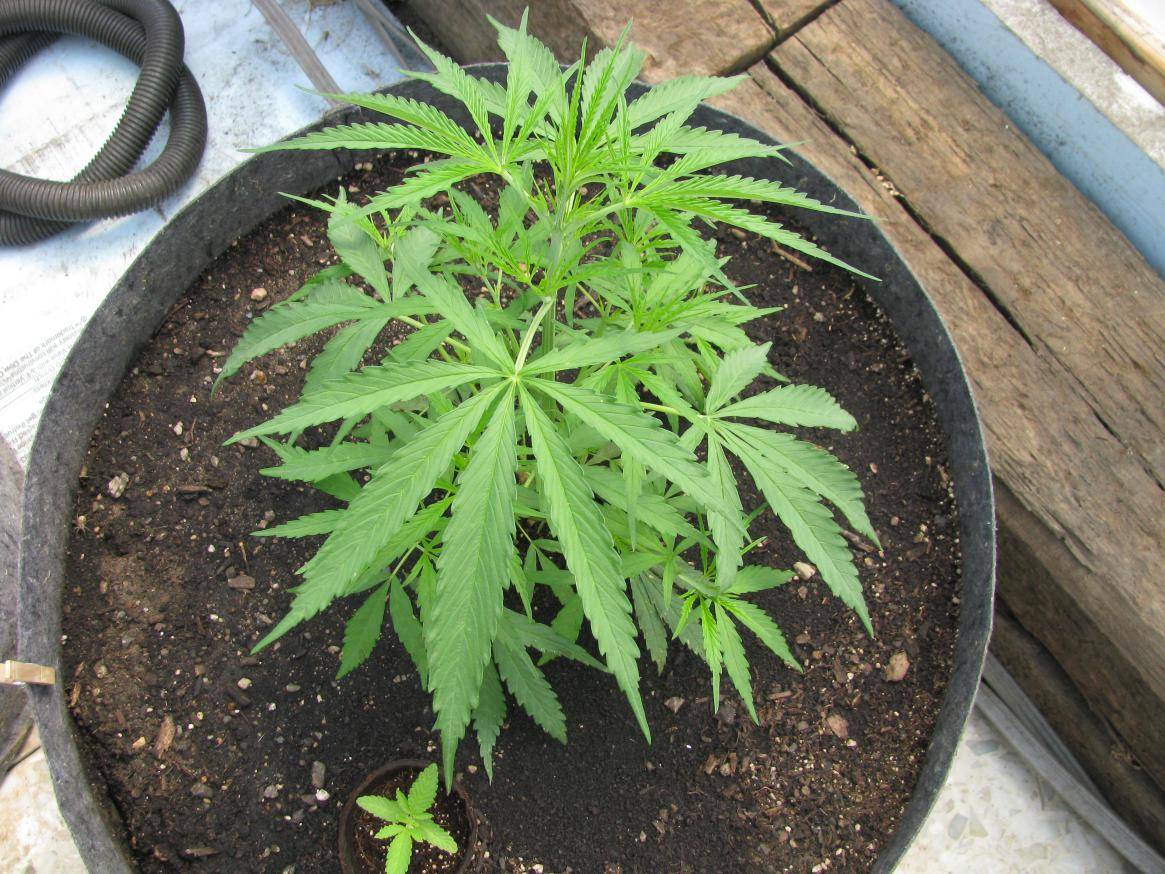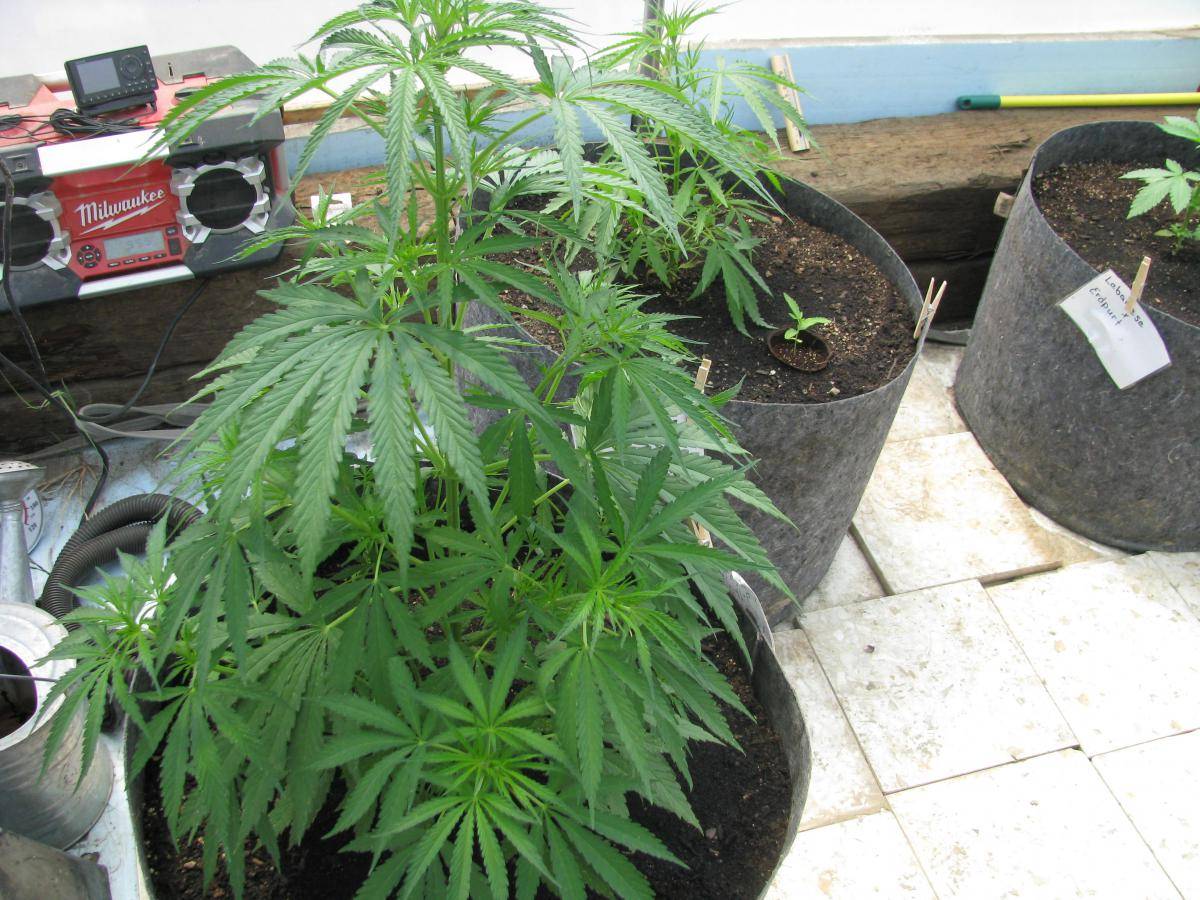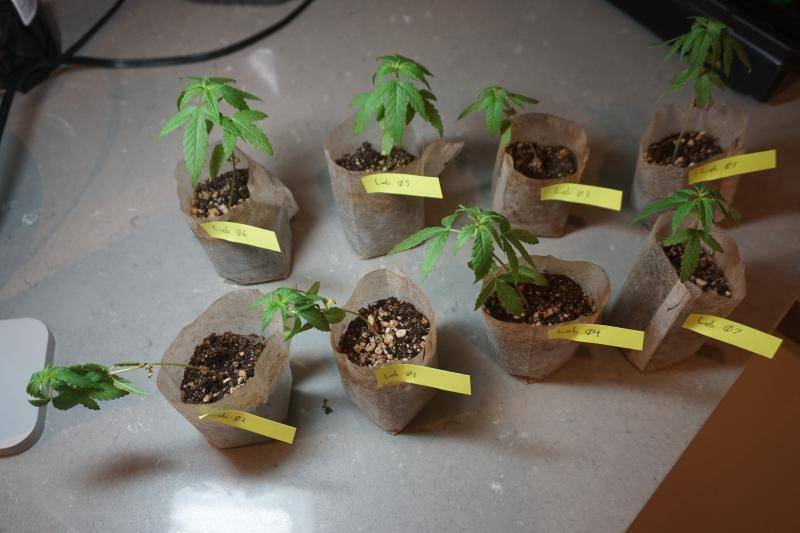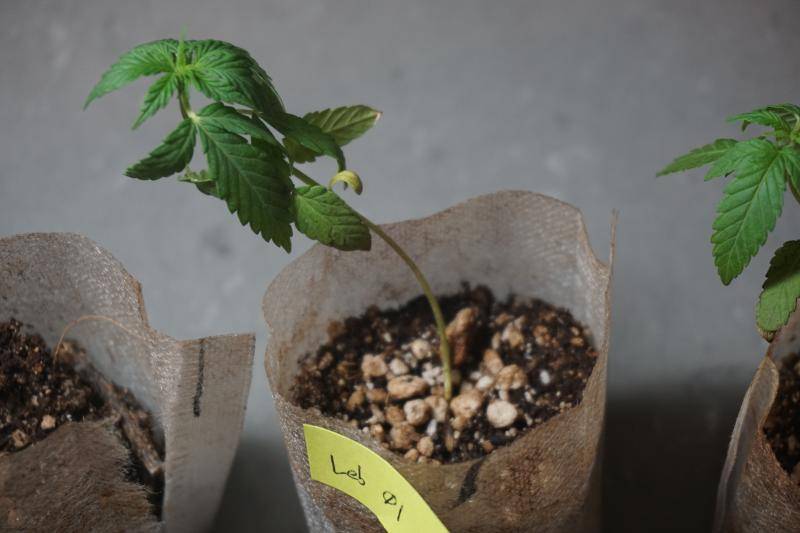You are using an out of date browser. It may not display this or other websites correctly.
You should upgrade or use an alternative browser.
You should upgrade or use an alternative browser.
Lebanese
- Thread starter dubi
- Start date
Repuk, I'm sure we both have great plants then. That one has another 2 to 3 weeks before she starts flowering. About a week or two for the other 3 plants. I would like to see them at least 3' or 1 meter before they switch. Peace brother
OregonBorn
Active member
Oregonborn, I meant genotype. Indica and sativa are genotypes. Phenotypes are the expression of the genotype in color, tastes and smells. If this had been a hybrid of the two. I would have used phenotype as you correctly pointed out. Either way I'm sure the breeder can figure out my question. Peace
Perhaps we are agreeing violently here, but in this case with a single genetic pool of landrace Lebanese seeds, they are described as expressing two distinct phenotypes; an indica form, and sativa form. The pheno difference here being leaf shape and plant habit. IMO and the opinion of Ace Seeds, the Lebanese landrace are all actually sativa genotype. Even though ALL of the literature that I have seen refers to Lebanese as indica.
I have bred these back and forth IBL, Lebanese sativa pheno x indica pheno and vice verse, and from different sources from the Bekaa Valley. They still pop variably sativa and indica phenos. I tend to get a higher ratio of indica phenos overall. I have photos showing the distinct differences, but uploading photos onto this site is an end around chore so it ain't gonna happen.
Oregonborn, we may be. Me knowing it's a true sativa, I find it hard to give it a indica phenotype discription . But for all purposes of explaining plant structure. The indica phenotype works very well. I still struggle with every dispensary calling a cross of a cross of a cross a strain. So many so called breeders can't produce a strain more than once. You look at their websites, everything over two years old is permanently out of stock.
I like your phrase of agreeing violently. I'm going to use that if you don't mind.
Happy father's day to you brother. Peace
I like your phrase of agreeing violently. I'm going to use that if you don't mind.
Happy father's day to you brother. Peace
GarcilazoMedia
New member
6-17 update
6-17 update
Hello all, These are where the four ladies are at this week. We've had a few more days of rain again. It's nice to have full rain barrels, but I'd rather haul water and have more sunshine.

The Lebanese #2

The Lebanese #1

The double planted Lebanese.
All the girls seem to be doing fine. There isn't any pistils poking out yet anywhere that I've noticed. The double planted Lebanese are in a heavier soil than the two single planted ladies. While the soil seems to remain moist, they get a little droopy by the time I'm off work. They could use a light mid day watering to keep them happier, but that isn't an option. Have a great day. Peace
6-17 update
Hello all, These are where the four ladies are at this week. We've had a few more days of rain again. It's nice to have full rain barrels, but I'd rather haul water and have more sunshine.
The Lebanese #2
The Lebanese #1
The double planted Lebanese.
All the girls seem to be doing fine. There isn't any pistils poking out yet anywhere that I've noticed. The double planted Lebanese are in a heavier soil than the two single planted ladies. While the soil seems to remain moist, they get a little droopy by the time I'm off work. They could use a light mid day watering to keep them happier, but that isn't an option. Have a great day. Peace
OregonBorn
Active member
Oregonborn, we may be. Me knowing it's a true sativa, I find it hard to give it a indica phenotype discription . But for all purposes of explaining plant structure. The indica phenotype works very well. I still struggle with every dispensary calling a cross of a cross of a cross a strain. So many so called breeders can't produce a strain more than once. You look at their websites, everything over two years old is permanently out of stock.
I like your phrase of agreeing violently. I'm going to use that if you don't mind.
Happy father's day to you brother. Peace
I did not coin the phrase 'agreeing violently.' It was a common term in many professional meetings I have endured. Use it freely, I do not mind.
As for not being able to reproduce strains, that happens for several reasons. Cannabis genetics are highly variable between the defined species (sativa, indica and ruderalis). Thus crossing an indica from Pakistan and a sativa from Colombia is going to give you a huge array of results in the F1 round. Completely unstable and most are crap and a select few are choice. You can clone them, but breeding the same select seeds is tough. F2 generations can be even more variable, and by F4 they are typically crap.
Which leads to the second reason for not being able to reproduce strains. So many mutts are out there from multiple chain and back crosses and between similar strains. OG and skunk whatever being prime examples. They all have the same genetics. Over-breeding these typically results in less interesting lines. The same thing happens when you breed plants IBL. By F4 they are mostly duds. I believe that these are the result of gene switching as Cannabis rapidly adapts to new environments. In all the literature going back to 1600 that I have read, people talk about strains of hemp and Mj going amok in about 4 generations when they are grown in new environments. Adapting that fast has to be something other than chance mutation. Gene switching happens fast, and is common even in humans. No mutations are required, just flip a switch and you get different phenos in the next generation. This almost always results in less quality, be it for fiber, bud, or seed.
We'll I have two males and two females. Not sure which male I will cull and which to keep. The double planted plastic tub would be the easiest to move.
I have the indoor grow room ready. The three females I'm considering pollinating are ( Lebanese, Peyote Purple, and a Blueberry).
Peace
I have the indoor grow room ready. The three females I'm considering pollinating are ( Lebanese, Peyote Purple, and a Blueberry).
Peace
OregonBorn
Active member
We'll I have two males and two females. Not sure which male I will cull and which to keep. The double planted plastic tub would be the easiest to move.
I have the indoor grow room ready. The three females I'm considering pollinating are ( Lebanese, Peyote Purple, and a Blueberry).
Peace
What strain are the males?
I have 3 males in my stable now, and I culled another 6. I have a Durban, a Maui and a Lebanese. I have the same in females but more of them, and I will breed them IBL. I also have frozen pollen from some indica and sativa landraces that I grew before. I dunno what would happen if I cross bred them. I cannot grow tons of plants in order to find the good ones and select for traits.
Last edited:
Oregonborn, the two males I was referring to are Lebanese. I have two Blueberry plants that are regular seeds as well. Neither have shown 100% what sex they are.
If I ended up with a Blueberry male I would pollinate a branch of one Lebanese and one Peyote Purple. There's a good chance the trifoliate Panama Deep Chunk would see some pollen as well.
I may have to pinch some nanners in the morning before work. Buy myself a few days to get things figured out and plants moved. I've never tried to store pollen.
What do you keep yours in container wise ? How long does it stay viable? Thanks Oregonborn peace
If I ended up with a Blueberry male I would pollinate a branch of one Lebanese and one Peyote Purple. There's a good chance the trifoliate Panama Deep Chunk would see some pollen as well.
I may have to pinch some nanners in the morning before work. Buy myself a few days to get things figured out and plants moved. I've never tried to store pollen.
What do you keep yours in container wise ? How long does it stay viable? Thanks Oregonborn peace
I'm limited to 19 grow bags in the greenhouse. Higher plant counts come at the expense of double planting in bags. Working any genetics properly is beyond my facilities ability. Maybe if I committed the season to one cross, I could do a little justice with selections. I need another greenhouse, that will piss the wife off. Peace
My two lebs look really different from each other, one is almost as tall as the Hondurans, while the other is really stout, stacking nodes pretty close:
View Image
Hi repuk,
Yes, there are indeed very vigorous and tall phenos in this lebanese line. Kindly post a pic of both plants together if you have the chance so we can appreciate better their differences.
Perhaps we are agreeing violently here, but in this case with a single genetic pool of landrace Lebanese seeds, they are described as expressing two distinct phenotypes; an indica form, and sativa form. The pheno difference here being leaf shape and plant habit. IMO and the opinion of Ace Seeds, the Lebanese landrace are all actually sativa genotype. Even though ALL of the literature that I have seen refers to Lebanese as indica.
I have bred these back and forth IBL, Lebanese sativa pheno x indica pheno and vice verse, and from different sources from the Bekaa Valley. They still pop variably sativa and indica phenos. I tend to get a higher ratio of indica phenos overall. I have photos showing the distinct differences, but uploading photos onto this site is an end around chore so it ain't gonna happen.
Hi OregonBorn,
Feel free to share more info and pics about the lebanese line you have been working with for several generations. It's always interesting to compare different populations and lines from the same place of origin.
As for not being able to reproduce strains, that happens for several reasons. Cannabis genetics are highly variable between the defined species (sativa, indica and ruderalis). Thus crossing an indica from Pakistan and a sativa from Colombia is going to give you a huge array of results in the F1 round. Completely unstable and most are crap and a select few are choice. You can clone them, but breeding the same select seeds is tough. F2 generations can be even more variable, and by F4 they are typically crap.
I disagree. In your example, if the colombian sativa and pakistani indica are enough inbred, then the resulting F1 hybrid of crossing both will produce quite stable results, the quality of the F1 hybrid depends mainly on the quality of the inbred lines used to produce it and in the genetic ability of the parental plants and parental lines to combine well, blending their best traits (and hopefully not so much the bad ones), enchanced them by F1 hybrid vigor.
It's the F2 generation that will be very variable in constrast with the F1's uniformity.
If you breed until F4 you will lose vigor and potency for sure (compared with F1 generation ), but it's the skill of the breeder to be able to stabilize the best traits in the line and to achieve this you usually need to reach at least F4-F6 generation, it will depend on the homozygosity/heterozygosity of the hybrid you are trying to stabilize, but you seldom achieve a degree of acceptable stabilization before reach F4 stage.
If the breeder reaches F4 breeding stage of the hybrid and it becomes crap then it means that breeder did something wrong in the selection process during previous generations. This happens frequently (breeders are humans are not all the breeding decisions are the best) and if that's the case then it is important to keep parental plants and seed lines from previous generations to start again from the successful point before making the selection failure.
To give you a few examples i'm more familiarized with, Kali China line really started to reach the level of quality and uniformity i was looking for in F4 stage.
Panama really started to show its fire from F6 generations onwards. Nepal Jam was really good in its F1 and in its first backcross to the nepalese, but line has been really been more consistent at F6 stage. Same for Bangi Haze, first generations were great, it lost the fire in generations inbetween to fortunately recover a good degree of quality back at the F8 stage after many efforts.
Anyway sorry for being off topic, this is general breeding. Let's keep the conversations of this thread mainly about our lebanese release, and also about other lebanese strains.
Last edited:
Hi 48N,
You can find the cannabinoid results of the most representative chemotypes we found in this lebanese line in the second post of the thread:
https://www.icmag.com/ic/showpost.php?p=8181408&postcount=2
The CBD:THC ratios range from 1:1, 2,5:1 and even 30:1, all the samples we analyzed had more CBD than THC.
You can find the cannabinoid results of the most representative chemotypes we found in this lebanese line in the second post of the thread:
https://www.icmag.com/ic/showpost.php?p=8181408&postcount=2
The CBD:THC ratios range from 1:1, 2,5:1 and even 30:1, all the samples we analyzed had more CBD than THC.
Sup guys! Thought I’d stop in and let you guys know im growing these outside this year. I’ll be documenting the grow and phenos that pop up and posting here. Happy season
Welcome GarcilazoMedia
Glad you got a good amount of lebanese seeds for this outdoor season. You should be able to find really interesting phenotypes and parental plants by growing 50-60 seeds.
Please, keep us updated with your progresses and results.
Have a greats season as well!
Hello all, These are where the four ladies are at this week. We've had a few more days of rain again. It's nice to have full rain barrels, but I'd rather haul water and have more sunshine.
[URL=https://www.icmag.com/ic/picture.php?albumid=76620&pictureid=1860118&thumb=1]View Image[/url]
The Lebanese #2
[URL=https://www.icmag.com/ic/picture.php?albumid=76620&pictureid=1860117&thumb=1]View Image[/url]
The Lebanese #1
[URL=https://www.icmag.com/ic/picture.php?albumid=76620&pictureid=1860116&thumb=1]View Image[/url]
The double planted Lebanese.
All the girls seem to be doing fine. There isn't any pistils poking out yet anywhere that I've noticed. The double planted Lebanese are in a heavier soil than the two single planted ladies. While the soil seems to remain moist, they get a little droopy by the time I'm off work. They could use a light mid day watering to keep them happier, but that isn't an option. Have a great day. Peace
Oregonborn, the two males I was referring to are Lebanese. I have two Blueberry plants that are regular seeds as well.
What do you keep yours in container wise ? How long does it stay viable? Thanks Oregonborn peace
Hi farmerlion
Really beautiful lebaneses, they are growing super fast and healthy, nice vigor right ?
To store the male pollen, collect it in a dry day in a tupperware and add silica gel inside to lower down mositure and extend the pollen fertility. Keep the container with the pollen inside the fridge at 5ºC, then you can use a paintbrush to 'paint' your females with the pollen, the pollen will have good viability in the upcoming 2-3 months after collect it, but don't trust that it will last much more unless you can collect huge quanties of pollen (i mean, a few gramms at least).
Thanks Dubi, I may have a two to three week overlap in time. Both males will be dropping pollen by the end of the week. I'm guessing mid July before the females are ready. Collect, store and paint may work best for me. I was thinking open pollination, but a few really need the best flowers more than I need more seeds. I will place another order this week and let the girls keep their virtue. Peace brother
LogRhythmic
New member
I'm posted my progress of my Lebanese / Ethiopian grow here, for anyone interested in the carnage. Next post will show some serious chaos, sadly.
https://www.icmag.com/ic/showthread.php?p=8320240
https://www.icmag.com/ic/showthread.php?p=8320240
LogRhythmic
New member
I'm having some serious issues with my Lebanese plants. If this is the wrong place for this please delete/move this to the infirmary.
I had to leave my plants in someone else's care, and unfortunately there was a misunderstanding. They were overwatered one day and then left outside too long (several hours) in the heat and wind two days later. Also, I'm aware that these containers are far too small for month old plants, but work and travel have kept me from getting to them for a transplant.
This morning vs later in the day(the ones without tags are the Lebanese):




Some useful information:
1. Mix is 7% castings, the rest is limed peat, coco and aeration.
2. Water is around pH 6.5
3. Every third watering or so they get TM-7 (humic/fulvic/micronutrients) and some half-strength liquid kelp - I didn't think to pH this and it may be closer to 5.0-5.5 but my pH paper is having some issues.
4. Overwatered two days ago.
5. Left in the elements today.
6. They have had one AACT application brewed with an airlift brewer.
Thanks in advance, and again, if this is the wrong place to post please move/delete this - I don't want to clutter up the thread but I am panicking.
I had to leave my plants in someone else's care, and unfortunately there was a misunderstanding. They were overwatered one day and then left outside too long (several hours) in the heat and wind two days later. Also, I'm aware that these containers are far too small for month old plants, but work and travel have kept me from getting to them for a transplant.
This morning vs later in the day(the ones without tags are the Lebanese):
Some useful information:
1. Mix is 7% castings, the rest is limed peat, coco and aeration.
2. Water is around pH 6.5
3. Every third watering or so they get TM-7 (humic/fulvic/micronutrients) and some half-strength liquid kelp - I didn't think to pH this and it may be closer to 5.0-5.5 but my pH paper is having some issues.
4. Overwatered two days ago.
5. Left in the elements today.
6. They have had one AACT application brewed with an airlift brewer.
Thanks in advance, and again, if this is the wrong place to post please move/delete this - I don't want to clutter up the thread but I am panicking.

 farmerlion! The last one you posted looks identical to my stout one.
farmerlion! The last one you posted looks identical to my stout one.
